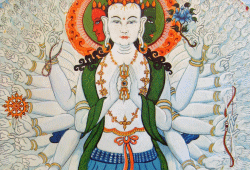  |
|
|
We at the Chenrezig Project are honored to be identified in name with a Buddhist entity as auspicious as Chenrezig. For our group and its members, individually and collectively, the qualities of Chenrezig serve as great and wonderful inspiration. In summary, Chenrezig is the Buddha of Compassion. When Buddhists define compassion, it is believed that Chenrezig is the embodiment of boundless loving-kindness and compassion. Every person whose heart is moved by love and compassion, who deeply and sincerely acts for the benefit of another person, animal or part of the natural world without concern for fame, profit, social position or recognition expresses the activity of Chenrezig. Love and compassion are the true signs revealing the presence of Chenrezig. Chenrezig may be the most popular of all Buddhist deities, except for Buddha himself -- he is beloved throughout the Buddhist world. He is known by different names in different lands: as Avalokiteshvara in the ancient Sanskrit language of India, as Kuan-yin in China, as Kannon in Japan. (Chenrezig is his name in the Tibetan language.) As Chenrezig, he is considered the patron Bodhisattva of Tibet, and his meditation is practiced in all the great lineages of Tibetan Buddhism. Some of the most respected meditation masters (lamas), like the Dalai Lamas and Karmapas, who are considered living Buddhas, are also believed to be emanations of Chenrezig. Chenrezig is also believed by Tibetans to be their "Adam," the actual progenitor of their race. In his form at his heart he holds a jewel, a symbol of universal love and compassion, symbolizing that in whatever way he manifests to benefit beings, the quality of Chenrezig's mind is never separate from the all pervasive state of primordial wisdom. In his outer right hand, Chenrezig is holding beads, moving them in the way one uses a mala to count mantras. This symbolizes that there is not one moment when Chenrezig does not benefit beings. Like the steady movement of counting the beads, Chenrezig is continuously benefiting sentient beings and turning the wheel of enlightened activity. In the outer left hand, Chenrezig holds a lotus flower. This symbolizes that Chenrezig, actively benefiting others, manifests with wisdom in whatever forms are necessary in accordance with the mental capacities, circumstances, and aptitudes of each sentient being. His mantra is "Om Mani Padme Hung" translated as "The jewel is in the lotus" signifying the indivisibility of compassion and wisdom. This from Robert Thurman's The Jewel Tree of Tibet (Free Press): "He (Chenrezig) is represented in many different forms, of course, but in one of the most beautiful he has eleven heads, a thousand arms, and a thousand eyes, with one eye in the palm of each hand. His arms symbolize his power of compassion to reach into every atom, every moment, and every life of every being, like a great king of Dharma. He is the king of reality, a king of compassion, helping everyone along the way to enlightenment, giving each a thousand helping hands, which are symbolic of an infinite number of helping hands. These helping hands are not just helping you according to what he thinks you need, but they are sensitive to what you really need, because he has infinite powers of sight. The palm of each hand has an eye, the most sensitive area of the body, and therefore he sees exactly what you need and how you need to be helped." |
|
|
